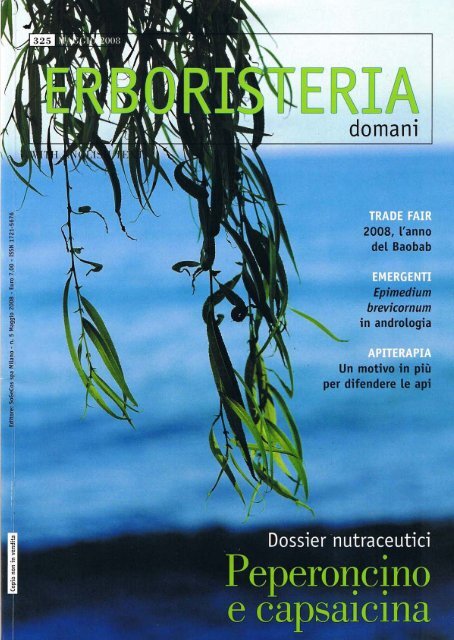Erboristeria Domani - Maggio 2008 - Baobab Fruit Company Senegal
Erboristeria Domani - Maggio 2008 - Baobab Fruit Company Senegal
Erboristeria Domani - Maggio 2008 - Baobab Fruit Company Senegal
You also want an ePaper? Increase the reach of your titles
YUMPU automatically turns print PDFs into web optimized ePapers that Google loves.
'@""'F"L@tlM"F •<br />
40 ERBORISTERIA DOMANI <strong>Maggio</strong> <strong>2008</strong>
<strong>2008</strong>, è l'anno del baobab<br />
.. te comune di numerose ricette, sia<br />
fresche che essiccate. Contengono TABELLA 1: CONTENUTO DEI FRUTTI DEL BAOBAB (MG/100 GDI POLPA)<br />
tutti gli aminoacidi essenziali e la<br />
maggior parte di quelli non essen<br />
ziali; sono pel1anto un'importante<br />
fonte proteica, particolarmente indicata<br />
nella nutrizione dei bambini,<br />
in mancanza di un sufficiente<br />
apporto di proteine animali. Sono<br />
ricche di mucillagini emollienti e<br />
per questo motivo sono utilizzate<br />
nella formulazione di prodotti cosmetici,<br />
oppure semplicemente aggiunte<br />
secche all'acqua del bagno.<br />
Nella farmacopea tradizionale sono<br />
impiegate per il trattamento della<br />
dialTea, della febbre, degli sta<br />
Proteine 2.3<br />
Lipidi 0.27<br />
Fibre solubili e insolubili 52.0<br />
Carboidrati 75.6<br />
Acido ascorbico (Vitamina C) 280-300 (in confronto: 51 nelle arance··)<br />
Calcio 257-370··· (in confronto: 125 nel latte··)<br />
Potassio 2.31<br />
Fosforo 96-118<br />
ti asmatici, delle malattie renali e<br />
urinarie. Macerate e poi compresse<br />
servono a calmare le infiammazioni<br />
da: Manfredini et al., 2002 (8); •• Yliufel et al., 1993 (13); "'Wllkinson, 200& (15)<br />
degli occhi, delle orecchie e delle lizzate per tingere i tessuti. La polpa del frutto<br />
punture d'insetto. l semi Quando il frutto è maturo la sua polpa<br />
La scorza Dai semi si estrae un buon olio, uti si presenta disidratata e gessosa, con<br />
La scorza serve a combattere le in lizzato sia nell'alimentazione che in un'umidità che non supera il 10 %.<br />
fiammazioni del tubo digerente e cosmesi. È ricco di acidi grassi es Sbriciolata forma una polvere di cocome<br />
febbrifugo in alternati va alla senziali, in particolare acido oleico, lore bianco-avorio, dal sapore gradecorteccia<br />
di china. In passato veni linoleico e linolenico (11). Dona alla volmente acidulo e dall'elevato conva<br />
importata in Europa con il nome pelle tono ed elasticità, rivitalizzando tenuto di acidi organici, in particolare<br />
di cortex cael cedra.<br />
Le radici<br />
Le radici ancora tenere sono eduli,<br />
in tempi brevi i tessuti epiteliali. Per<br />
questo è anche un valido sollievo in<br />
caso di scottature. I semi tostati sono<br />
acido ascorbico e tartarico. Notevole<br />
è inoltrela presenza di calcio e fibre<br />
solubili einsolubili (vedi tab. 1). Viesimili<br />
alle carote. Allo stato adulto commestibili, di sapore simile ai pi ne tradizionalmente usata per fare becontengono<br />
una sostanza colorante stacchi e con essi si prepara anche un vancle rinfrescanti e, visto il suo alto<br />
di rosso e vengono per questo uti- buon surrogato del caffè. contenuto di pectina, per adclensare<br />
42 ERBORISTERIA DOMANI <strong>Maggio</strong> <strong>2008</strong><br />
L'aspetto imponente e maestoso del baobab ne fa l'albero simbolo della savana africana
The forthcoming, yet still not achieved, authorisation to market<br />
<strong>Baobab</strong> pulp fruit as novel food could give in the next future new<br />
popularity to this gread african natural resource. <strong>Baobab</strong> (scientific<br />
name: Adansania digitata) is one of the most classical icons of Africa,<br />
used in logos and in the denomination of a number of non prafit associations,<br />
travel agencies, trading companies.<br />
<strong>Baobab</strong> is the common name of a genus (Adansonia) containing eight<br />
species of trees, native to Madagascar as well as mainland Africa. The<br />
leaves are commonly used as a leaf vegetable thraughout the area of<br />
mainland African distribution, including Malawi, Zimbabwe, and the<br />
Sahel. They are eaten both fresh and as a dry powder. In Nigeria, the<br />
leaves are locally<br />
known as<br />
kuka, and are<br />
used to make<br />
kuka soup.<br />
40<br />
The fruit is extremely nutritious and is known as sour gourd or monkey's<br />
bread. The dry pulp of the fruit, after separation fram the seeds and fibers,<br />
is eaten directly or mixed into porridge or milk.<br />
Food consumption of the baobab has found new<br />
potentialities after reecent studies on the relevant<br />
antioxydant and antiinflammatory praperties, linked<br />
to a valuable content in vitamin Cand calcium, and<br />
on the prebiotic action of the fibers contained in the page<br />
fruit pulp.<br />
e scenes<br />
of <strong>Erboristeria</strong> <strong>Domani</strong><br />
Apitherapy is, simply said, the use of Bee Products to prevent,<br />
heal or recover somebody fram one or more diseases or conditions.<br />
Once more, the borders between food and medicine seem uneasy to<br />
fit. A number of scientists coming from all over the world will meet<br />
in Rome, fram 9 to 12 June, on the occasion of the International<br />
Congress "Apimedica and Apiquality <strong>2008</strong>" jointly organized by the<br />
Tor Vergata University, the Federation of Italian Beekeepers and<br />
by Apimondia, the international federation of beekeepers associations.<br />
Propolis, pollen, bee venom, rayal jelly have a clear "medical<br />
characterisation"; but the Rome conference will present also recent<br />
studies on particular honey varieties (such as manuka honey from<br />
New Zealand) that have clinically shown antibiotic and skin soothin<br />
properties. <strong>Erboristeria</strong> <strong>Domani</strong> will feature a post-conference review<br />
of the most interesting data and presentations.<br />
<strong>Maggio</strong> <strong>2008</strong> ERBORISTERIA DOMANI 75


